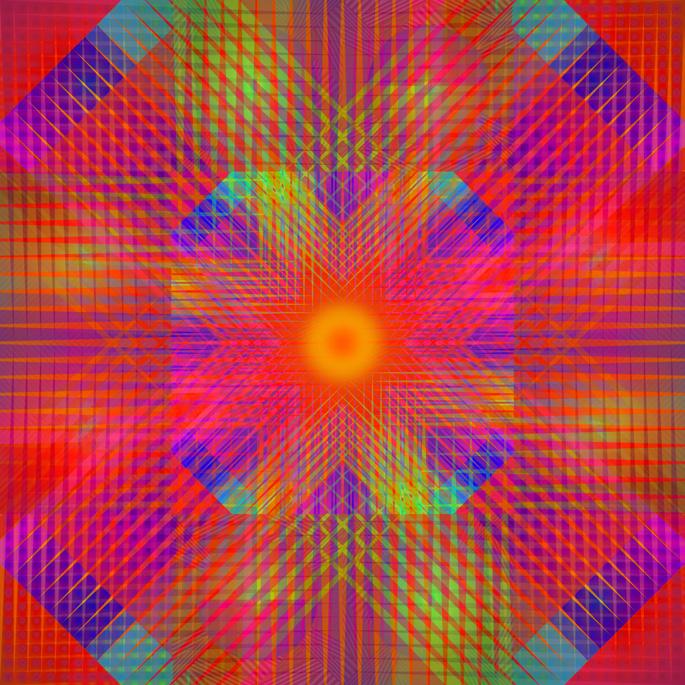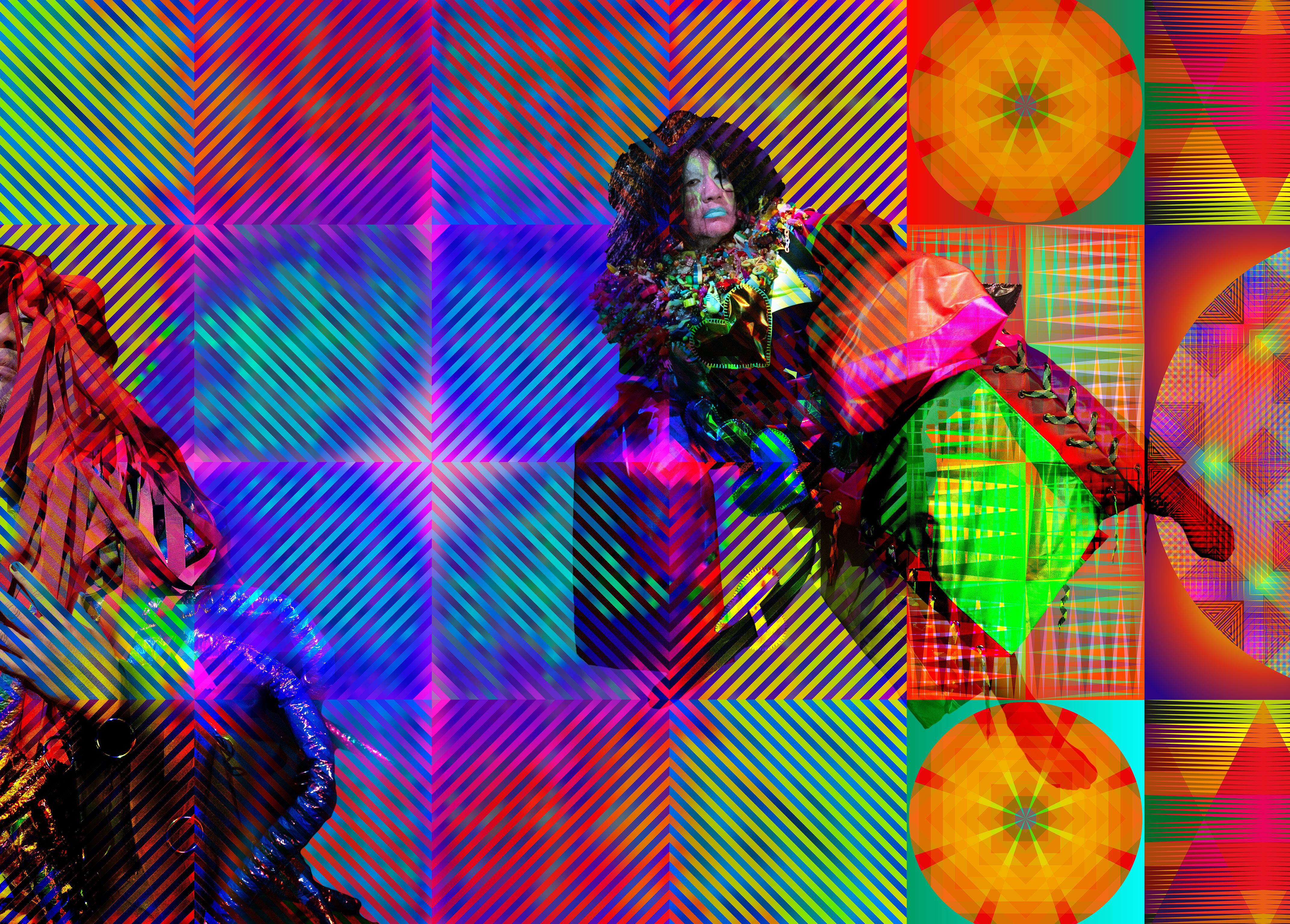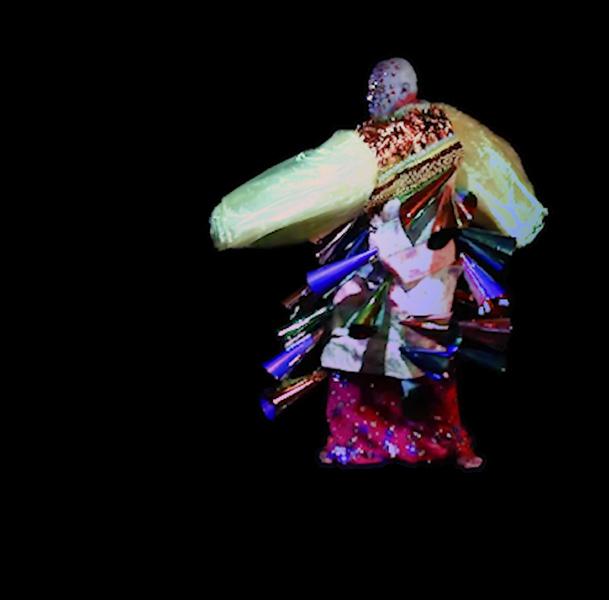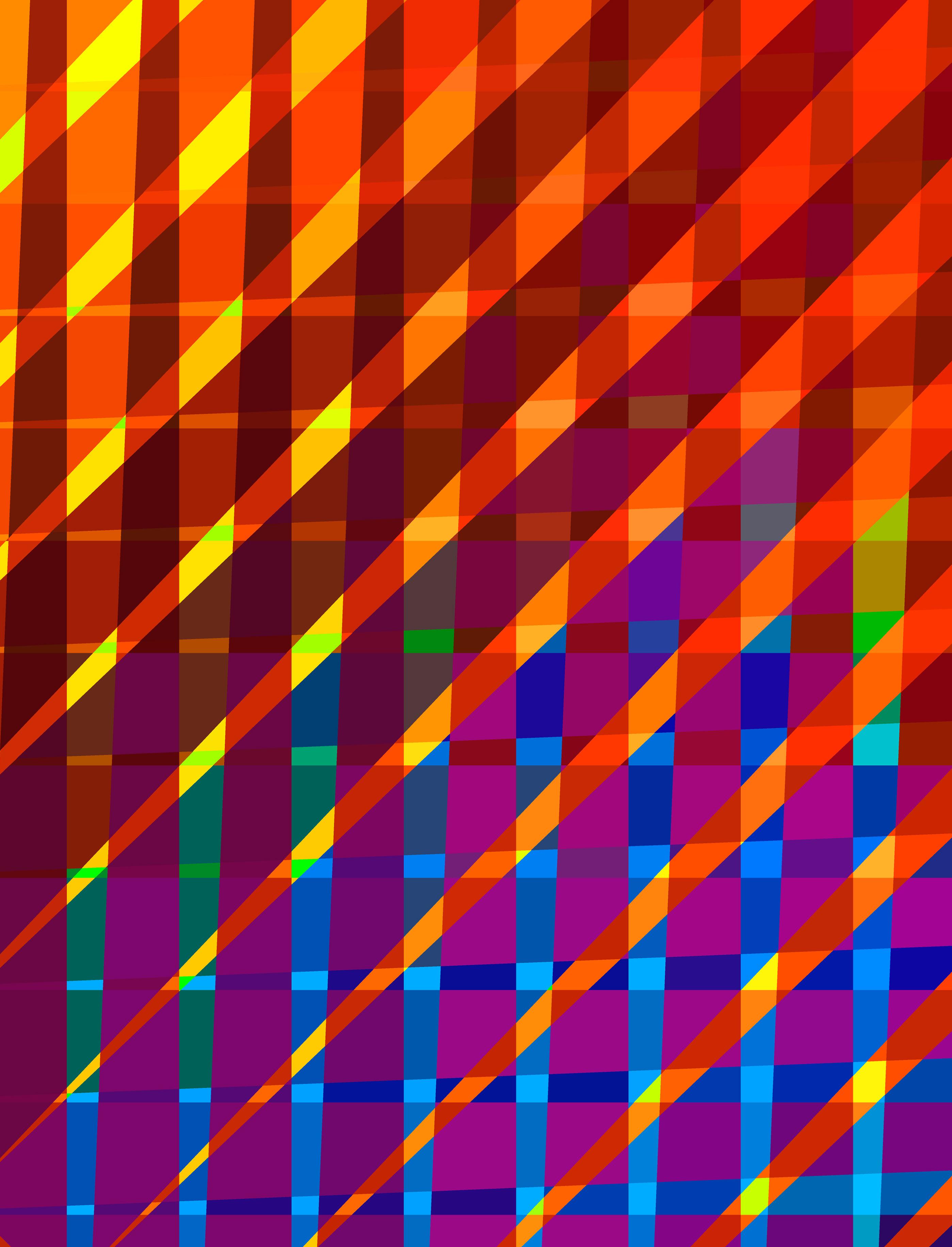




by DENISE MARKONISH
The siren song returns to me, I sing it across her throat: Am I what I love? Is this the glittering world I’ve been begging for? 2
—
NATALIE DIAZ
( mojave )
So many things led to this exact moment, but let’s start with the glittering world, the love that we are all begging for. This shimmering world permeates Jeffrey Gibson’s work physically, but also serves as an intense declaration, a “we are here moment” that brings Indigeneity and queerness to the forefront. For years Gibson, who is Choctaw and Cherokee, has led the fight for visibility, yet more recently (following his historic role as the first Indigenous artist to represent the United States in a solo exhibition at the Venice Biennale) he looks both to his ancestors and historic artists as much as the next generation. He states “I come out of the generation that fought intensely for representation and inclusion. That’s where my ambition really came from: You will include us. You will show us. We will be present. Witnessing and engaging with a younger generation for whom representation is no longer just enough is illuminating. The question now is ‘What if we were both the authors of and the audience for our own voices?’” 3 POWER FULL BECAUSE WE’RE DIFFERENT is just the unapologetic shout that is needed in this exact moment the allcaps, and the deliberate use of “POWER FULL” instead of “POWERFUL”; a community full with power is one that touts difference as a point of shimmering celebration.
The glittering world that is Gibson’s exhibition takes root in two historic moments. The first involves Leigh Bowery , the
3

London-based Australian performance artist, club promoter, and fashion designer. Bowery was known as a muse and model for the painter Lucian Freud, but mostly he was notorious for his wildly creative costumes, makeup, and gender-bending performances; contemporary drag culture would not exist without this visionary producer. In 1988, Bowery was invited by the Anthony d’Offay Gallery in London to create a new performance, the artist’s debut in the art world. For one week Bowery took up residence in the gallery’s front window, which was fitted with a one-way mirror. Bowery brought costumes, makeup, and props and spent his time preening, striking poses, and performing for himself in the mirror. While he only saw his own reflection, he knew that he was performing for people on the street. This revealing/concealing
unabashedly upended the times’ societal norms of beauty, identity, and otherness. Bowery died of AIDS-related illnesses in 1994, just before Gibson moved to London. Though Gibson missed Bowery, someone he counts as a savior, he has remained inspired by his predecessor ever since.
Two years after Bowery’s performance, the third Annual Gathering of Native American Gays and Lesbians took place in Winnipeg, Manitoba, Canada. At this gathering, Dr. Myra Laramee (First Nations Cree) brought the term TwoSpirit to the group after it appeared to her in a dream. Laramee makes clear that she did not invent the phrase but rather that it was a sacred term. Albert McLeod (Nisichawayasihk Cree Nation and the Metis community of Norway House in
northern Manitoba), who was instrumental in organizing the gathering and has led activism around Two-Spirit and LGBTQIIA+ (or 2SLGBTQIIA+) rights to this day, states that the term “affirms that we are spiritual beings aligned in balance with all facets of creation. The act of “spirit-naming” is an act of decolonization; for example, First Nations have replaced the colonial names of their communities with new names in their Indigenous languages. The term “Two-Spirit” re-affirms for Indigenous LGBTQ+ people that we are linked spiritually to our families, communities, and nations. This affirmation



also links us to the spiritual teachings that strengthen our relationship with the natural worlds and dimensions, ex. plant, animal, water, weather, astronomy, etc.”4
From these histories POWER FULL BECAUSE WE’RE DIFFERENT takes shape. Gibson cannot undertake such work alone, so from its inception the
4 Harlan Pruden, “Two-Spirit Turns 30!!,” Two Spirit Journal, August 3, 2020, https://twospiritjournal.com/?p=973.



exhibition was an invitation to over thirty Indigenous contributors from across North America, to collectively create a space where difference is not only considered, it is celebrated. Upon entering MASS MoCA’s Building 5 gallery, visitors are met with a thumping soundtrack part Indigenous drumming / part techno beat and five suspended video screens. On the central screen is the 1992 documentary Two Spirit People directed by Michel Beauchemin, Lori Levy, and Gretchen


Vogel, which features Indigenous TwoSpirit individuals discussing the term and their identities on the streets of the Bay Area. The film, released just two years after the phrase Two-Spirit came into consciousness, is not without its complications: the use of the colonialist term “berdache,” originally stemming from the Iranian term for sexual slave, and offensively used to describe non-gender conforming Indigenous peoples; and the fact that one of the participants in the film has since been outed as not Indigenous. However, for Gibson this documentary still provides a look at a specific time in which the Queer Indigenous community began insisting on visibility on their own terms.
The documentary plays on the middle of the five hanging screens. It is on the four screens, split on either side of the documentary, that Gibson brings Two-Spirit into the present. Titled Your Spirit Whispers in My Ear, the work began with the collection of videos from more than 20 Two-Spirit DJs, drag performers, academics, and activists: Sean Stevens and Adrian Snyder, Ty Fierce, Metteba Navi Ho, Carla Rossi, Joseph Pierce, Miko Thomas, Morgan Wallace, Arielle Twist, Lou Cornum, Kairyn Potts, Lady Shug, Beejee (Qahir-beejee Llaneza) Peco, Cocoa Chandelier, Jontay Kahm, Dan Taulapapa McMullin, Razelle Benally, Hulleah Tsinhnahjinnie, Yoli, Hinaleimoana Wong-Kalu, Charlie Amáyá Scott, Kira Xonorika, Evan James Atwood, and Theo Jean Cuthand. The contributions were edited by Sancia

Miala Shiba Nash, with a soundtrack by Patrick “Reachout” Coll. The video is like a kaleidoscope with documentary footage interlaced with preening drag queens, texts stating things like “land back,” and dancing. It is a celebration of sovereignty, power, and agency, as the Two-Spirit community unapologetically declares its presence. They are indeed power full, a chorus that is echoed in contemporary 2SLGBTQIA+ writing, such as Qwo-Li Driskill’s statement: “We were stolen from our bodies, but now we are taking ourselves back. First Nations Two-Spirits are blooming like dandelions in the landscape of a racist, homophobic, and transphobic culture’s ordered garden. Through over 500 years of colonization’s efforts to kill our startling beauty, our roots have proven too deep and complicated to pull out of the soil of our origin, the soil where we are
nurtured by the sacrifices that were made by our ancestors’ commitment to love us.” 5 Or Rafael/a Luna-Pizano’s phrase “We are made of wind and water, ash and bone, mascara and dawn, precariously positioned and ready to live, do not let us fall in vain…”6
Coll’s soundtrack and Nash’s rhythmic editing turn the gallery into an ecstatic club, with the bass thumping in the soles of our feet. Accompanying the video are three stages, made out of
5 Qwo-Li Driskill, “Stolen from our Bodies: First Nations Two-Spirits/Queers and the Journey to a Sovereign Erotic,” Studies in American Indian Literatures, January 2024, p. 61
6 Rafael/a Luna-Pizano, ““Unknown Devotions: Trans* and Indigena Freedom Dance” in Honoring Our Ancestors: Takatāpui, Two-Spirit and Indigenous LGBTQI+ Well-Being, eds., Alison Green and Leonie Pihama (Wellington: Te Herenga Waka University Press, 20230, p. 336.
LEFT: Stages
ABOVE: Video still from Sometimes your body changes and you don't remember your dreams, 2024. Two-channel video. Video filmed by Evan Benally Atwood. Sound composed and edited by Jeffrey Gibson and Patrick ‘Reachout’ Coll


fused glass panels. The composition of each stage references Gibson’s painting style bold patterns that blend Indigenous-inspired geometries with those of modernist painting and psychedelic colors. Lit from below, the stages glow in the darkened space, highlighting the corresponding garments that hang above each. These garments are adorned with beads and found materials, and are made of neon ombre material, ribbons, and textiles that Gibson designed based on paintings and sculptures in the studio. Gibson has been making garments, both as sculpture and for performance, since the early 2010s. Originally inspired by Lakota Ghost Dance garments from a pacifist movement that originated with the Northern Paiute and culminated in the 1890 Wounded Knee massacre, today the garments are informed by regalia worn in faith-based ceremonies, and for Gibson they pay homage to the past while signaling hope for the future.
Over the years, Gibson’s garments have become more complex; while still wearable, they require assistance to be activated. When hanging above the stage they appear aspirational, with long fringe

descending well past the cuffs of sleeves or an ornate collar made of plastic trinkets worn over a floor-length leather harness. These works also find form in club culture and kitsch, another homage to Bowery’s 1980s London scene. The presence of these garments cannot be ignored, and they speak to us in texts printed or embroidered across their surfaces. One contains the phrase “people like us,” which taken together with “birds of a feather” unapologetically references Indigenous and queer community visibility. Of this Gibson states: “…imagine what it would look like if we were the majority. Let us be greater than the sum of our parts. Let us not be frightened by change.” 7 Another garment has “I’m haunted by you” embroidered in delicate cursive over the heart, while the same script (Gibson’s hand) appears like a breastplate on a garment covered in iridescent snakes. Here the text reads “All things that led to this exact moment.” This declaration is both for Gibson as an artist, and for the ongoing struggle of decolonization and queer Indigenous equality.
An additional four stages and corresponding garments occupy the second half of the gallery, but before that section is reached visitors must pass through a portal a floor-to-ceiling, end-to-end patterned mirror wall. The wall heightens the vertiginous and kaleidoscopic feeling


within the gallery due to its bright color and pattern and its reflective quality which doubles and amplifies everything around it, making the space feel infinite and immersive. Along one side of the wall, there is a passageway visitors can use to reach the other space, where the mirror wall continues and appears again on the back wall of the gallery. This journey functions like a portal. When Gibson first spoke to Albert McLeod about the origin of Two-Spirit and what it means today, they discussed not just gender or sexuality but the way in which Two-Spirit is a recognition of the spiritual self. So here, this transitional space becomes a sign of strength not knowing what is on the other side, yet continuing the journey anyway, knowing that if you are true to yourself, you will be met with safety and support.
At MASS MoCA, the space beyond the portal brings light. If the first zone of the exhibition conjured a nightclub, the
second half, full of windows, functions like a chapel. Patterned transparent vinyl fills the 63 windows flanking the gallery; each contains Gibson’s signature triangle patterns which collectively create two halves of a gradient circle (the bottom half on the west wall and the top half of the east wall). Atop the hard-edged geometry is a wash of painterly gestures and snippets of text: “your spirit whispering in my ear,” “born of the earth,” and one particularly poignant text that Gibson’s six-year-old daughter spoke to him: “Sometimes your body changes and you don’t remember your dreams.” This phrase also appears on one of the most diaphanous garments in the exhibition, and in many ways brings tender humanity to the fierceness of being POWER FULL.
Much like the invitation to video contributors, Gibson intends the stages and garments to be activated. For this, he invited North American Indigenous artists, across all genres, to propose takeovers
of his exhibition. The group which included Laura Ortman, Black Belt Eagle Scout (Katherine Paul), Takiaya Reed (Divide and Dissolve), Martha Redbone, MX Oops, Arielle Twist, devynn emory, Zoon, Emily Johnson, Raven Chacon, Eric-Paul Riege, Lou Cornum, and Demian DinéYazhi' first gathered in the spring of 2023 at MASS MoCA and the Forge Project.8 They then submitted proposals for performances on stages, activations of garments, and/or sound and video takeovers. Over the 18-month exhibition these contributions will enliven the space. Additionally, Building 5’s upper mezzanine is home to a resource room (curated by Antonia Oliver and Gibson) that highlights contributors to the projects through video, playlists, books, costumes, historic documents, texts, and posters.
The final chapter of POWER FULL BECAUSE WE’RE DIFFERENT comes back to Gibson and Bowery. In the lower mezzanine of Building 5 sits a new two-channel video installation, which marks the first time in over a decade that Gibson has performed in his work. This video is a direct reference to Bowery’s 1988 residency, but here Gibson performs for the camera wearing all seven garments in the exhibition. Filmmaker Evan Benally Atwood shot the artist in a black void, or portal. Despite the extremity of the garments, their bulk, materials, and weight, Gibson floats in space, a radiant futurist being full of serenity and power a being that wouldn’t exist without all things that led to this exact moment: joy to pain. TwoSpirit writer Joshua Whitehead sums up this feeling: “...we will walk into the future, in whatever form that may take, together, hand in hand, strong, resilient, extraneously queer, and singing a round dance song that calls us all back in together… we have lived in torture chambers, we have excelled under the weight of killing machines, we’ve hardened into bedrock see how our bodies dazzle in the light?” 9

8 Forge Project, in New York State on the unceded lands of the Moh-He-Con-Nuk, is a Native-led nonprofit whose mandate is to cultivate and advance Indigenous leadership in arts and culture. https:// forgeproject.com/
9 Joshua Whitehead, “Introduction,” Love After the End: An Anthology of Two-Spirit & Indigiqueer Speculative Fiction, ed Joshua Whitehead (Vancouver: Arsenal Pulp Press, 2020), p 12.
LEFT & BELOW: Video stills from Sometimes your body changes and you don't remember your dreams, 2024. Two-channel video. Video filmed by Evan Benally Atwood. Sound composed and edited by Jeffrey Gibson and Patrick ‘Reachout’ Coll


Jeffrey Gibson (b. 1972, Colorado Springs, CO; lives/works in New York) grew up in major urban centers in the United States, Germany, Korea, and the U.K. A mid-career multidisciplinary artist, he is a citizen of the Mississippi Band of Choctaw Indians and half Cherokee, whose practice includes sculpture, painting, printmaking, video, and performance. Gibson earned his MA in painting at the Royal College of Art, London, in 1998 and his BA in painting from the School of the Art Institute of Chicago in 1995. His work is in the permanent collections of the Denver Art Museum; Museum of Fine Arts, Boston; Smithsonian Institution’s National Museum of the American Indian; National Gallery of Canada; Crystal Bridges Museum of American Art; the Museum of Modern Art; and the Whitney Museum of American Art. Gibson is a past TED Foundation Fellow and a Joan Mitchell Grant recipient. He is a recipient of the 2019 MacArthur Foundation Fellowship. He is an artist-in-residence at Bard College and lives and works near Hudson, New York. Gibson currently represents the United States at the 60th edition of La Biennale di Venezia. He is the first Indigenous artist to represent the United States with a solo presentation in the national pavilion.

Jeffrey Gibson: POWER FULL BECAUSE WE’RE DIFFERENT
November 3, 2024 – June 2026
Curated by Denise Markonish, Chief Curator, MASS MoCA
Support for Jeffrey Gibson: POWER FULL BECAUSE WE’RE DIFFERENT is provided by the Henry Luce Foundation, the Coby Foundation, Ltd., the National Endowment for the Arts, The Andy Warhol Foundation, the Emily Hall Tremaine Foundation, the Mellon Foundation, Nicole Deller and Matt Bliwise, and Stuart and Lisa Ginsberg in memory of their aunt, Marilyn Eber. In-kind support is provided by Decorative Films.
Programming at MASS MoCA is made possible in part by the Horace W. Goldsmith Foundation and Mass Cultural Council.
Unless otherwise noted, all images are Jeffrey Gibson: POWER FULL BECAUSE WE’RE DIFFERENT, 2024, courtesy of Jeffrey Gibson Studio.


